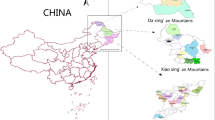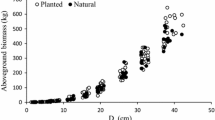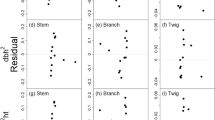Abstract
Key message
Seemingly unrelated mixed-effects models were used to model biomass models for Larix olgensis, Pinus koraiensis, and Pinus sylvestris, and the developed models considered multiple variables to enhance the practicality of the models.
Abstract
Korean larch (Larix olgensis), Korean pine (Pinus koraiensis), and Mongolian pine (Pinus sylvestris) are important coniferous species in the northeastern area of the P.R. China; hence, accurate biomass estimates of these species are meaningful for evaluating forest health and calculating carbon storage. Based on the tree variables of diameter at breast height (\(DBH\)), tree height (\(H\)), age, live crown length and crown width, three log-transformed species-specific biomass functions were developed using linear seemingly unrelated regression (SUR) since the error structures of the component biomass model (stem, branches, foliage and roots) were proven to be multiplicative. Furthermore, the plot-level random effect was introduced into the SUR model, namely the SURM model, to achieve more accurate biomass estimates. The results showed that the SURM model has a better fitting performance than the SUR models for three species and model types. The determination coefficient, \({R}^{2}\), was always larger for the SURM models than for the corresponding SUR models, while the root mean square error, \({\text{RMSE}}\), was always smaller for the SURM models. By leave-one-out validation, the SURM models were proven to provide more accurate predictions because the mean prediction percent error (\({\text{MPE}}\)) was close to 0 and the mean absolute percentage error (\({\text{MAPE}}\)) was smaller than that of the corresponding SUR models across species and model types. In addition, the size and design of the sample used to calibrate for random effects were assessed using the \({\text{MAPE}}\) statistical index, \({\text{MAPE}}\). The calibration of the SURM showed a decreasing pattern of bias as the sample size increased, indicating that more available sampled trees improved the prediction accuracy of SURM models, while only slight differences existed across sampling designs. Overall, the newly developed biomass models have advantages in various data structures, and will be meaningful and useful in terms of accurately predicting the biomass of three important species in Northeast China.





Similar content being viewed by others
Data availability
The data underlying this article cannot be shared publicly because the data are also being used in ongoing studies. The data will be shared upon reasonable request to the corresponding authors.
References
Affleck DLR, Dieguez-Aranda U (2016) Additive nonlinear biomass equations: a likelihood-based approach. For Sci 62:129–140
António N, Tomé M, Tomé J, Soares P, Fontes L (2007) Effect of tree, stand, and site variables on the allometry of Eucalyptus globulus tree biomass. Can J For Res 37:895–906
Baskerville GL (1972) Use of logarithmic regression in the estimation of plant biomass. Can J For Res 4:149–149
Bi H, Turner J, Lambert MJ (2004) Additive biomass equations for native eucalypt forest trees of temperate Australia. Trees 18:467–479
Bi H, Murphy S, Volkova L, Weston C, Fairman T, Li Y, Law R, Norris J, Lei X, Caccamo G (2015) Additive biomass equations based on complete weighing of sample trees for open eucalypt forest species in south-eastern Australia. For Ecol Manag 349:106–121
Blujdea VNB, Pilli R, Dutca I, Ciuvat L, Abrudan IV (2012) Allometric biomass equations for young broadleaved trees in plantations in Romania. For Ecol Manag 264:172–184
Bond-Lamberty B, Wang C, Gower ST (2004) Net primary production and net ecosystem production of a boreal black spruce wildfire chronosequence. Glob Change Biol 10:473–487
Bravo-Oviedo A (2018) The role of mixed forests in a changing social-ecological world. In: Bravo-Oviedo A, Pretzsch H, del Río M (eds) Dynamics, silviculture and management of mixed forests. Springer, Cham, pp 1–25
Bronisz K, Mehtatalo L (2020) Seemingly unrelated mixed-effects biomass models for young silver birch stands on post-agricultural lands. Forests 11:381
Cawley GC, Talbot NLC (2003) Efficient leave-one-out cross-validation of kernel Fisher discriminant classifiers. Pattern Recognit 36:2585–2592
Chave J, Réjou-Méchain M, Búrquez A, Chidumayo E, Colgan MS, Delitti WBC, Duque A, Eid T, Fearnside PM, Goodman RC, Henry M, Martínez-Yrízar A, Mugasha WA, Muller-Landau HC, Mencuccini M, Nelson BW, Ngomanda A, Nogueira EM, Ortiz-Malavassi E, Pélissier R, Ploton P, Ryan CM, Saldarriaga JG, Vieilledent G (2014) Improved allometric models to estimate the aboveground biomass of tropical trees. Glob Change Biol 20:3177–3190
Chen C, Zhu J (1989) A handbook for main tree species biomass in Northeast China. China Forestry Press, Beijing
Colmanetti MAA, Weiskittel A, Scolforo HF, Sotomayor JFM, do Couto HTZ, (2020) Calibrating individual tree biomass models for contrasting tropical species at an uneven-aged site in the native Atlantic Forest of Brazil: a direct comparison of alternative approaches, sample sizes, and sample selection methods. For Ecol Manag 473:118306
Correia AC, Faias SP, Ruiz-Peinado R, Chianucci F, Cutini A, Fontes L, Manetti MC, Montero G, Soares P, Tome M (2018) Generalized biomass equations for Stone pine (Pinus pinea L.) across the Mediterranean basin. For Ecol Manag 429:425–436
Dixon RK, Solomon AM, Brown S, Houghton RA, Trexier MC, Wisniewski J (1994) Carbon pools and flux of global forest ecosystems. Science 263:185–190
Dong L, Zhang L, Li F (2014) A compatible system of biomass equations for three conifer species in Northeast, China. For Ecol Manag 329:306–317
Dong L, Zhang L, Li F (2015) Developing additive systems of biomass equations for nine hardwood species in Northeast China. Trees Struct Funct 29:1149–1163
Dong L, Zhang L, Li F (2016a) Developing two additive biomass equations for three coniferous plantation species in Northeast China. Forests 7:136
Dong LH, Zhang LJ, Li FR (2016b) Allometry and partitioning of individual tree biomass and carbon of Abies nephrolepis Maxim in northeast China. Scand J For Res 31:399–411
Dong L, Zhang L, Li F (2018) Additive biomass equations based on different dendrometric variables for two dominant species (Larix gmelini Rupr. and Betula platyphylla Suk.) in natural forests in the Eastern Daxing’an Mountains, Northeast China. Forests 9:261
Dong L, Zhang Y, Zhang Z, Xie L, Li F (2020) Comparison of tree biomass modeling approaches for Larch (Larix olgensis Henry) trees in Northeast China. Forests 11:202
Finney DJ (1941) On the distribution of a variate whose logarithm is normally distributed. J R Stat Soc Ser B Stat Methodol 7:155–161
Forrester DI, Tachauer IHH, Annighoefer P, Barbeito I, Pretzsch H, Ruiz-Peinado R, Stark H, Vacchiano G, Zlatanov T, Chakraborty T, Saha S, Sileshi GW (2017) Generalized biomass and leaf area allometric equations for European tree species incorporating stand structure, tree age and climate. For Ecol Manag 396:160–175
Forrester DI, Dumbrell IC, Elms SR, Paul KI, Pinkard EA, Roxburgh SH, Baker TG (2020) Can crown variables increase the generality of individual tree biomass equations? Trees 35:15–26
Fu LG, Li N, Mill RR (1999) Pinaceae. Flora China 4:11–52
Fu L, Sun W, Wang G (2017) A climate-sensitive aboveground biomass model for three larch species in northeastern and northern China. Trees 31:557–573
Gonzalez-Benecke CA, Gezan SA, Albaugh TJ, Allen HL, Burkhart HE, Fox TR, Jokela EJ, Maier CA, Martin TA, Rubilar RA, Samuelson LJ (2014) Local and general above-stump biomass functions for loblolly pine and slash pine trees. For Ecol Manag 334:254–276
Gonzalez-Benecke CA, Zhao D, Samuelson LJ, Martin TA, Leduc DJ, Jack SB (2018) Local and general above-ground biomass functions for Pinus palustris trees. Forests 9:310
Jiang L, Liu M, Liu Y (2013) Variation of wood basic density and early selection of Dahurian Larch and Mongolian Pine. J Beijing For Univ 35:1–6
Kerkhoff AJ, Enquist BJ (2009) Multiplicative by nature: why logarithmic transformation is necessary in allometry. J Theor Biol 257:519–521
Kralicek K, Bao H, Christian S, Hailemariam T, Krishna PP (2017) Simultaneous estimation of above- and below-ground biomass in tropical forests of Viet Nam. For Ecol Manag 390:147–156
Kusmana C, Hidayat T, Tiryana T, Rusdiana O, Istomo (2018) Allometric models for above- and below-ground biomass of Sonneratia spp. Glob Ecol Conserv 15:e00417
Lai J, Yang B, Lin D, Kerkhoff AJ, Ma K (2013) The allometry of coarse root biomass: log-transformed linear regression or nonlinear regression? Plos One 8:e77007
Li Y, Zhang S, Liu H (1986) Variations in density and strength of wood of Korean Pine and Larch from northeast of China and the Lumber stress grading. Sci Silv Sin 22:380–392
Luo Y, Wang X, Ouyang Z, Lu F, Feng L, Tao J (2020) A review of biomass equations for China’s tree species. Earth Syst Sci Data 12:21–40
Madgwick HAI, Satoo T (1975) On estimating the aboveground weights of tree stands. Ecology 56:1446–1450
Maltamo M, Mehtatalo L, Vauhkonen J, Packalen P (2012) Predicting and calibrating tree attributes by means of airborne laser scanning and field measurements. Can J For Res 42:1896–1907
Mascaro J, Litton CM, Hughes RF, Uowolo A, Schnitzer SA (2014) Is logarithmic transformation necessary in allometry? Ten, one-hundred, one‐thousand‐times yes. Biol J Linn Soc 111:230–233
Mehtätalo L, Lappi J (2020) Biometry for forestry and environmental data with examples in R. CRC Press, Boca Raton
Ounban W, Puangchit L, Diloksumpun S (2016) Development of general biomass allometric equations for Tectona grandis Linn.f. and Eucalyptus camaldulensis Dehnh. plantations in Thailand. Agric Nat Resour 50:48–53
Parresol BR (2001) Additivity of nonlinear biomass equations. Can J For Res 31:865–878
Pinheiro J, Bates D (2000) Mixed-effects models in S and S-Plus. Springer, New York
Porté A, Trichet P, Bert D, Loustau D (2002) Allometric relationships for branch and tree woody biomass of Maritime pine (Pinus pinaster Aı̈t.). For Ecol Manag 158:71–83
Pregitzer KS, Euskirchen ES (2004) Carbon cycling and storage in world forests: biome patterns related to forest age. Glob Change Biol 10:2052–2077
R Core Team (2019) R: a language and environment for statistical computing. R Foundation for Statistical Computing, Vienna
SAS Institute Inc (2018) SAS/ETS® 15.1 user’s guide. SAS Institute Inc, Cary
Schroeder P (1992) Carbon storage potential of short rotation tropical tree plantations. For Ecol Manag 50:31–41
Somogyi Z, Cienciala E, Makipaa R, Muukkonen P, Lehtonen A, Weiss P (2007) Indirect methods of large-scale forest biomass estimation. Eur J For Res 126:197–207
Song L, Zhu J, Zheng X, Wang K, Lu L, Zhang X, Hao G (2020) Transpiration and canopy conductance dynamics of Pinus sylvestris var. mongolica in its natural range and in an introduced region in the sandy plains of Northern China. Agric For Meteorol 281:107830
State Forestry and Grassland Administration (2019) The ninth forest resource survey report (2014–2018). China forestry press, Beijing
Wang C (2006) Biomass allometric equations for 10 co-occurring tree species in Chinese temperate forests. For Ecol Manag 222:9–16
Wang J, Fan J, Fan X, Zhang C, Wu L, v Gadow K (2013) Crown and root biomass equations for the small trees of Pinus koraiensis under canopy. Dendrobiology 70:13–25
Widagdo FRA, Li F, Zhang L, Dong L (2020a) Aggregated biomass model systems and carbon concentration variations for tree carbon quantification of natural Mongolian Oak in northeast China. Forests 11:397
Widagdo FRA, Xie L, Dong L, Li F (2020b) Origin-based biomass allometric equations, biomass partitioning, and carbon concentration variations of planted and natural Larix gmelinii in northeast China. Glob Ecol Conserv 23:e01111
Xiao X, White EP, Hooten MB, Durham SL (2011) On the use of log-transformation vs. nonlinear regression for analyzing biological power laws. Ecology 92:1887–1894
Xie L, Widagdo FRA, Dong L, Li F (2020) Modeling height–diameter relationships for mixed-species plantations of Fraxinus mandshurica Rupr. and Larix olgensis Henry in Northeastern China. Forests 11:610
Yu B (2008) Artificial cultivation techniques of Larix olgensis. Heilongjiang Sci Technol Inf 35:193
Zeng W-S (2015) Using nonlinear mixed model and dummy variable model approaches to develop origin-based individual tree biomass equations. Trees 29:275–283
Zeng D, Chen G, Chen F, Zhao Q, Ji X (2005) Foliar nutrients and their resorption efficiencies in four Pinus sylvestris var. mongolica plantations of different ages on sandy soil. Sci Silv Sin 41:21–27
Zeng W, Li L, Wei J, Ma K, Sun J, Wang X, Li Z, Xiao Q, Xu D, Yan H, Bai W (2016) Tree biomass models and related parameters to carbon accounting for Larix: LY/T 2654 – 2016. State Forestry Administration, Beijing
Zeng W, Duo H, Lei X, Chen X, Wang X, Pu Y, Zou W (2017) Individual tree biomass equations and growth models sensitive to climate variables for Larix spp. in China. Eur J For Res 136:233–249
Zhao D, Kane M, Markewitz D, Teskey R, Clutter M (2015) Additive tree biomass equations for midrotation loblolly pine plantations. For Sci 61:613–623
Zhao D, Westfall J, Coulston JW, Lynch TB, Bullock BP, Montes CR (2019) Additive biomass equations for slash pine trees: comparing three modeling approaches. Can J For Res 49:27–40
Zheng L-L, Zhao Q, Sun Q-Y, Liu L, Zeng D-H (2020) Nitrogen addition elevated autumn phosphorus retranslocation of living needles but not resorption in a nutrient-poor Pinus sylvestris var. Mongolica plantation. For Ecol Manag 468
Zianis D, Xanthopoulos G, Kalabokidis K, Kazakis G, Ghosn D, Roussou O (2011) Allometric equations for aboveground biomass estimation by size class for Pinus brutia Ten. trees growing in North and South Aegean Islands, Greece. Eur J For Res 130:145–160
Acknowledgements
The authors would like to thank the faculty and students of the Department of Forest Management, Northeast Forestry University (NEFU), China, who collected and provided the data for this study.
Funding
This research was financially supported by the National Key R&D Program of China (No. 2017YFD0600402), the Natural Science Foundation of China (No. 31971649), the Fundamental Research Funds for the Central Universities (No. 2572020DR03), the Provincial Funding for National Key R&D Program of China in Heilongjiang Province (No. GX18B041), and the Heilongjiang Touyan Innovation Team Program (Technology Development Team for High-efficient Silviculture of Forest Resources).
Author information
Authors and Affiliations
Corresponding authors
Ethics declarations
Conflict of interest
None declared.
Additional information
Publisher’s Note
Springer Nature remains neutral with regard to jurisdictional claims in published maps and institutional affiliations.
Supplementary Information
Below is the link to the electronic supplementary material.
Rights and permissions
About this article
Cite this article
Xie, L., Fu, L., Widagdo, F.R.A. et al. Improving the accuracy of tree biomass estimations for three coniferous tree species in Northeast China. Trees 36, 451–469 (2022). https://doi.org/10.1007/s00468-021-02220-w
Received:
Accepted:
Published:
Issue Date:
DOI: https://doi.org/10.1007/s00468-021-02220-w




